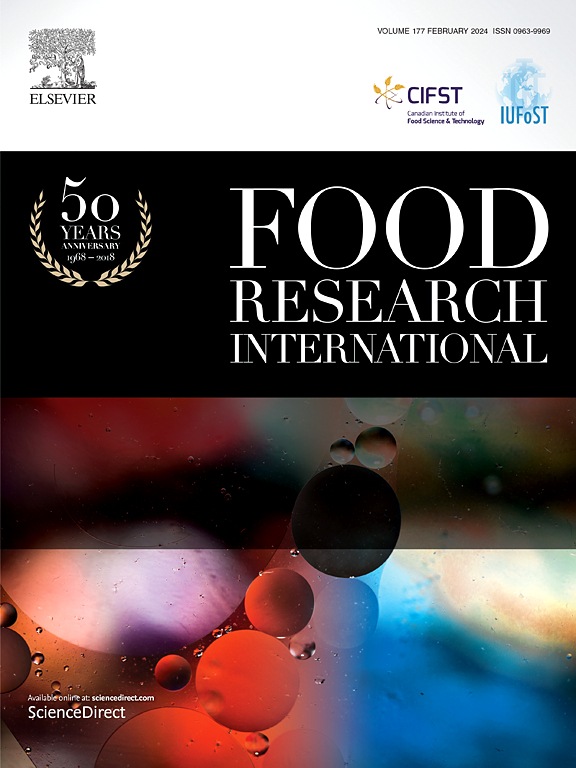Unraveling the alkaloid diversity and pharmacological potential of Ocimum: Integrated UPLC-MS/MS, network pharmacology, and transcriptomic insights for functional food and drug discovery
IF 8
1区 农林科学
Q1 FOOD SCIENCE & TECHNOLOGY
引用次数: 0
Abstract
As a dual-purpose medicinal and edible plant, Ocimum species offer significant pharmacological potential through their alkaloid metabolites. This study comprehensively analyzed alkaloid profiles in 10 Ocimum accessions using ultra performance liquid chromatography-tandem mass spectrometry (UPLC-MS/MS), integrated with network pharmacology, molecular docking, and transcriptome sequencing to elucidate key pharmacological targets, therapeutic potentials, and biosynthetic pathways. We identified 191 alkaloids categorized into eight classes, with phenolamine and plumerane alkaloids predominating. Differential metabolite analysis revealed pronounced genetic diversity in alkaloid composition across accessions. Network pharmacology identified 14 pharmacologically active alkaloids linked to 160 potential targets, where core targets were enriched in cancer and neurological disease pathways. Molecular docking validated the strongest binding affinities of N-p-coumaroyltyramine and N-cis-feruloyltyramine to key targets, associating them with Alzheimer's disease and cardiovascular disorders. Transcriptomic analysis highlighted the pivotal role of the 4-coumarate-CoA ligase (4CL) genes in regulating alkaloid biosynthesis. This work systematically deciphers the biosynthetic network and pharmacological mechanisms of Ocimum alkaloids for the first time, proposing two accessions G085 and G134 as prioritized resources for targeted drug development. These findings provide both theoretical and practical foundations for advancing Ocimum resource utilization, deepening molecular insights into alkaloid biosynthesis while demonstrating their potential as novel drug candidates to address global health challenges.

揭示Ocimum的生物碱多样性和药理潜力:集成UPLC-MS/MS,网络药理学和转录组学见解,用于功能性食品和药物发现
作为一种药用和食用两用植物,酢浆草通过其生物碱代谢物提供了显著的药理潜力。本研究利用超高效液相色谱-串联质谱(UPLC-MS/MS)技术,结合网络药理学、分子对接和转录组测序,全面分析了10种Ocimum植物的生物碱谱,以阐明关键的药理靶点、治疗潜力和生物合成途径。共鉴定出191种生物碱,分为8类,以酚胺类和虫胺类生物碱居多。差异代谢物分析显示,不同品种的生物碱组成具有明显的遗传多样性。网络药理学鉴定出14种具有药理活性的生物碱,这些生物碱与160个潜在靶点有关,其中核心靶点在癌症和神经疾病途径中富集。分子对接验证了n -对-香豆酰乙胺和n -顺-阿铁酰乙胺与关键靶点的最强结合亲和力,并将其与阿尔茨海默病和心血管疾病联系起来。转录组学分析强调了4-香豆酸辅酶a连接酶(4CL)基因在调节生物碱生物合成中的关键作用。本文首次系统地解读了八角藤生物碱的生物合成网络和药理机制,提出了G085和G134两个目录作为靶向药物开发的优先资源。这些发现为推进Ocimum资源利用,深化生物碱生物合成的分子见解,同时展示其作为解决全球健康挑战的新型候选药物的潜力提供了理论和实践基础。
本文章由计算机程序翻译,如有差异,请以英文原文为准。
求助全文
约1分钟内获得全文
求助全文
来源期刊

Food Research International
工程技术-食品科技
CiteScore
12.50
自引率
7.40%
发文量
1183
审稿时长
79 days
期刊介绍:
Food Research International serves as a rapid dissemination platform for significant and impactful research in food science, technology, engineering, and nutrition. The journal focuses on publishing novel, high-quality, and high-impact review papers, original research papers, and letters to the editors across various disciplines in the science and technology of food. Additionally, it follows a policy of publishing special issues on topical and emergent subjects in food research or related areas. Selected, peer-reviewed papers from scientific meetings, workshops, and conferences on the science, technology, and engineering of foods are also featured in special issues.
 求助内容:
求助内容: 应助结果提醒方式:
应助结果提醒方式:


